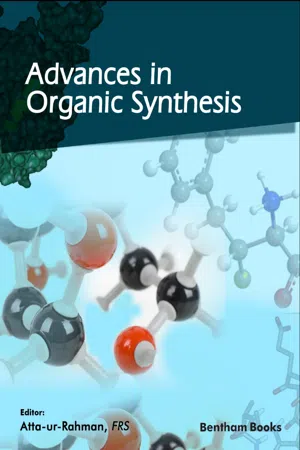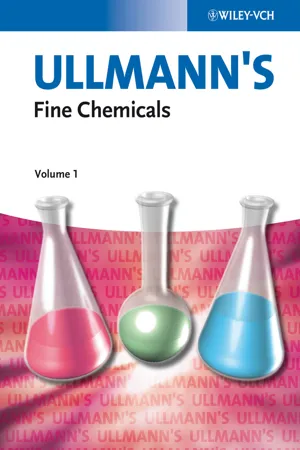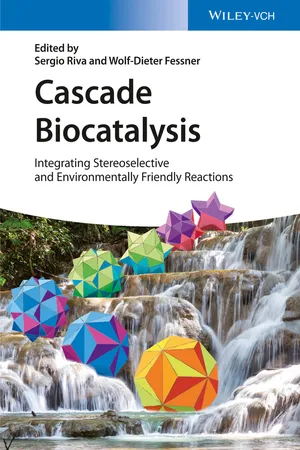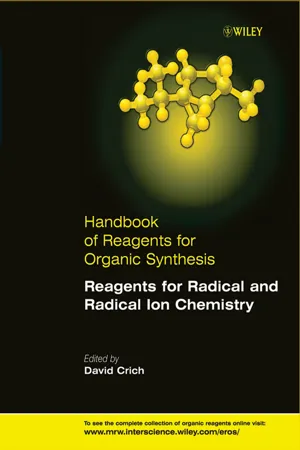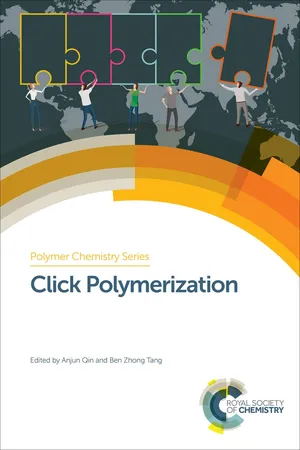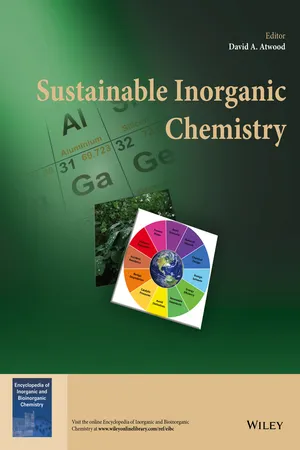Chemistry
Nitrile synthesis
Nitrile synthesis refers to the chemical process of creating nitrile compounds, which contain a carbon triple-bonded to a nitrogen atom. This can be achieved through various methods, such as the reaction of organic halides with metal cyanides or the dehydration of primary amides. Nitriles are versatile building blocks in organic synthesis and are used in the production of pharmaceuticals, agrochemicals, and materials.
Written by Perlego with AI-assistance
Related key terms
8 Key excerpts on "Nitrile synthesis"
- eBook - ePub
- Ning Jiao, Shannon S. Stahl, Ning Jiao, Shannon S. Stahl(Authors)
- 2019(Publication Date)
- Wiley(Publisher)
7 Green Oxidative Synthesis of NitrilesLaura M. Dornan, Qun Cao, and Mark J. MuldoonQueen's University Belfast, Belfast, United Kingdom7.1 Introduction
The nitrile group is an important functionality. Nitriles are intermediates in the synthesis of a wide variety of organic compounds, as well as being present in products ranging from pharmaceuticals [1 ] to materials [2 ]. Figure 7.1 illustrates a few examples of nitrile containing compounds and details of their applications.Examples of chemicals containing the nitrile functional group.Figure 7.1Unfortunately, the synthesis of the nitrile group often poses significant challenges. For example, methods that have typically been used by synthetic chemists for the preparation of aromatic nitriles such as the Rosenmund–von Braun reaction and the Sandmeyer reaction rely on stoichiometric metal cyanides. Due to the problems associated with such methods, there has been a move toward catalytic approaches [3 ] and the use of alternative (non‐metallic) sources of the cyano groups [4 ]. Nonetheless, a further improvement would be to move away from methods that rely on aryl halides all together and that utilize readily accessible substrates. Catalytic oxidation methods are highly attractive from this point of view and in fact many important nitriles are produced in such a manner on a very large scale [5 ]. So called “ammoxidation” normally involves the catalytic oxidation of an alkene or aromatic compound in the presence of ammonia. The production of acrylonitrile (Figure 7.1 ) from propene (using the Sohio Process), is perhaps the best‐known example of industrial ammoxidation, producing this commodity chemical in the multi‐million‐ton scale. Typically, ammoxidation reactions are performed at high temperature between 400 and 550 °C with high pressure and large excess of ammonia; conditions that limit the substrate scope to relatively simple substrates such as toluene, xylenes, and methyl pyridines. Therefore, such methods have limited applicability for laboratory synthesis of nitriles or indeed the production of functionalized molecules commonly found in pharmaceuticals and agrochemicals. This chapter will focus on recent developments in the area of oxidation catalysis for Nitrile synthesis, where the conditions are milder and readily accessible for synthetic chemists. In recent years, there has been an incredible growth in the number of such publications, and there is now a plethora of new synthetic methods for the preparation of nitriles. Indeed, there have been a number of review articles published recently that discuss a range of approaches [3 , 4 , 6 –8 ]. Here, we will examine catalytic oxidative methods that avoid the use of stoichiometric metal cyanide salts and in‐line with the ethos of this book, we will focus on methods that use O2 - eBook - ePub
- Atta-ur-Rahman(Author)
- 2021(Publication Date)
- Bentham Science Publishers(Publisher)
4 ].Scheme (1)) Some methods for the preparation of nitriles: Ammoxidation (A), hydrocyanation (B), Cyanohydrin formation, (C), and Sandmeyer Reaction (D).Besides their application in polymers, nitriles are also present in more than 30 pharmaceuticals, including antidepressants, antidiabetics, and anticancer drugs (Fig.Fig. (1)) Example of Nitrile-containing compounds in clinical use.), since they can act as hydrogen acceptors, increase water solubility and shield the drug from oxidative metabolism [5 - 8 ].1Moreover, the majority of nitriles are relatively stable and inexpensive compounds that support a high variation of substituents and can be converted into many functional groups (SchemeScheme (2)) Example of the conversion of nitriles into some common functional groups: ketone (A), carboxylic acid (B), aldehyde (C), and amine (D).) and heterocycles by various processes. Therefore, nitriles are interesting reagents in the synthesis of robust and diverse molecular libraries that may be used in high throughput screening assays on the search for novel drug candidates [9 , 10 ].2Five membered-ring azaheterocycles have been extensively explored in medicinal chemistry and are present in many marketed drugs. Some of them, such as pyrrole, indole, triazole, and imidazole are found in top-selling drugs [11 , 12 ] and many more are found in bioactive molecules [13 , 14 ].Therefore, considering the importance of the nitrile functional group as a precursor to many azaheterocycles, in this work we will review the new synthetic methodologies, reported from 2014 to 2020, for the synthesis of some prominent 5-membered azaheterocycles via - eBook - ePub
- (Author)
- 2014(Publication Date)
- Wiley-VCH(Publisher)
Nitriles Peter Pollak, Lonza AG, Basel, Switzerland Gérard Romeder, Lonza AG, Basel, Switzerland Ferdinand Hagedorn, Bayer AG, Leverkusen, Federal Republic of Germany Heinz-Peter Gelbke, BASF Aktiengesellschaft, Ludwigshafen, Federal Republic of Germany1. Introduction
Organic compounds containing the – CN group are generically called nitriles. The term “nitrile” refers to the triply bound nitrogen atom, ≡ N, and not to the carbon atom attached to it; therefore numbering of the aliphatic chain starts with that carbon atom (e.g., 4-chlorobutyronitrile describes the chemical formula ClCH2 CH2 CH2 CN).Nitriles R – CN are usually viewed as derivatives of the corresponding acids R – COOH. Consequently, they are also named by changing the ending “ic acid” or “oic acid” to “onitrile” (e.g., glutaric acid → glutaronitrile; dodecanoic acid → dodecanonitrile, propiononitrile, as an exception, is commonly referred to as propionitrile). Another way of naming nitriles is to state the name of the group R and use the prefix “cyano” or the suffix “cyanide” (e.g., cyanoethane and ethyl cyanide both describe H3 CCH2 CN). Nitriles that are obtained by addition of hydrogen cyanide to ketones or aldehydes and thus have both a hydroxy and a cyano group attached to the same carbon atom are commonly termed cyanohydrins (e.g., acetone cyanohydrin is identical to 2-hydroxy-2-methylpropionitrile). The same nomenclature applies to 3-hydroxypropionitrile which is commonly named ethylene cyanohydrin.2. Aliphatic Nitriles
Aliphatic nitriles are important starting materials for polymers as well as for the synthesis of e.g., pharmaceuticals and pesticides.2.1. Physical Properties
The carbon – nitrogen bond is extremely polar, which results in nitriles having a high dipole moment. This large dipole moment leads to intramolecular association; hence, nitriles have higher boiling points than would be expected from their molecular mass. Most of the lower molecular mass aliphatic nitriles (up to C13 H27 CN) are liquids at room temperature. Simple nitriles such as acetonitrile, propionitrile, glycolonitrile, and malononitrile are miscible with water; the latter two having a higher solubility because of the presence of two polar groups. Nitriles with higher molecular mass are sparingly water-soluble. Nitriles are good solvents for both polar and nonpolar solutes. The physical properties of selected nitriles are listed in Table 1 - eBook - ePub
Cascade Biocatalysis
Integrating Stereoselective and Environmentally Friendly Reactions
- Sergio Riva, Wolf-Dieter Fessner, Sergio Riva, Wolf-Dieter Fessner(Authors)
- 2014(Publication Date)
- Wiley-VCH(Publisher)
Chapter 11 Nitrile Converting Enzymes Involved in Natural and Synthetic Cascade ReactionsLudmila Martínková Andreas Stolz, Fred van Rantwijk, Nicola D'Antona, Dean Brady, and Linda G. Otten11.1 Introduction
Nitrile containing compounds are widely used in synthetic chemical industry and are abundant in nature. Because they can be toxic, mutagenic, and carcinogenic as they belong to the cyano group, nature has a plethora of enzymes to metabolize these compounds very efficiently. The pathways involved in the metabolism of nitriles in nature consist of an intricate pattern of fine-tuned enzymes (Figure 11.1 ), which have been extensively studied over the last decades [1–6]. From a synthetic perspective, nitriles are simple to synthesize through several organic chemical pathways from cheap substrates. Therefore, they are important intermediates in the chemical industry for production of amines, amides, amidines, carboxylic acids, esters, aldehydes, ketones, and heterocyclic compounds. The use of biological systems for the production of these commodity or specialty chemicals is a logical alternative to traditional chemical methods, because of the high yields that can often be obtained, the mild reaction conditions required, and the specialized activities possessed by some enzymes [7].Different pathways in nature concerning nitrile compounds. Figure partly reproduced from [1] with kind permission from Springer Science and Business media.Figure 11.1The enzymatic part in organic synthesis is usually performed as a single step, but because nature has attuned whole pathways to metabolize nitriles, the use of multienzymatic cascade reactions is more often employed nowadays [8]. In these organic synthesis processes, both natural cascades and man-made pathways are used. This chapter describes the mechanisms and operation of both natural and artificial cascades developed in the past decade. In addition to describing different enzyme systems, each section shows synthetic applications in academic and industrial settings using these cascades. Most described cascades show different enzymatic actions on the same group of a molecule, but the last two sections show how enzymatic cascades can also be performed on different regions of the same molecule in order to get to more efficient synthetic pathways. - eBook - ePub
- Gopinathan Anilkumar, Salim Saranya(Authors)
- 2020(Publication Date)
- Wiley-VCH(Publisher)
10 ], and the reader is advised to consult these for further details. The sections of this chapter are categorized based on the source of the nitrile group.19.2 Cyanation Reaction Using CN-Containing Source
19.2.1 Metallic Bound CN-Source
19.2.1.1 Metal Cyanide
The classic synthetic route to the aryl nitrile involves the direct use of stoichiometric amounts of highly toxic cyanide sources such as NaCN, KCN, CuCN, trimethylsilyl cyanide (TMSCN ), Zn(CN)2 , and AgCN and harsh reaction conditions (such as high reaction temperature) (Scheme 19.1 ). Such drawbacks limit their use in sustainable and green organic synthesis as well as organic transformation in the presence of sensitive functional groups.A general widely accepted mechanism for the Cu-catalyzed direct cyanation reaction [11 ] is shown in Scheme 19.2 .In 2003, improved copper-catalyzed domino halogen exchange cyanation was reported under mild reaction conditions with excellent functional group tolerance. As shown in Scheme 19.3 , cyanation procedure for several aryl bromides was performed using 10 mol% of CuI, 1.0 equiv of N,N′-dimethyl ethylenediamine as a ligand, and 1.2 equiv of NaCN in toluene at 110 °C yield aryl nitrile in good yield [12 ].Classic synthetic route for the synthesis of aryl nitriles.Scheme 19.1Direct cyanation reaction using copper cyanide and its general mechanism.Scheme 19.2Source: Ellis and Romney-Alexander 1987 [11 ]. Reproduced with permission of American Chemical Society.Copper-catalyzed cyanation reaction of aryl halides with NaCN.Scheme 19.3Regioselective cyanation of several aromatic heterocycles including benzoxazole, benzothiazole, benzimidazole, caffeine, triazole, N-methyl indole, and azulene can be done in good yield using catalytic CuCN and NaCN as a cyanide source in the presence of iodine as an oxidant (Scheme 19.4 ). This method follows a two-step protocol: the first step is iodination of acidic heterocyclic C—H bond, followed by in situ cyanation of the iodo intermediate [13 - eBook - ePub
- David Crich, David Crich(Authors)
- 2013(Publication Date)
- Wiley(Publisher)
Matthew S. LongPeakdale Molecular, Chapel-en-le-Frith, UKReactions of the Nitrile Group
Although the majority of acrylonitrile reactivity involves the alkene moiety, there are several functional group conversions the nitrile can undergo. Various well-established methods exist for the hydrolysis of acrylonitrile to either acrylamide or acrylic acid. Recent additions include the high-yielding hydrolysis of acrylonitrile to acrylamide using alumina supported Rh(OH)n and water (eq 14) .63 The same transformation can be carried out using a colloid containing particles of Cu/Pd.64(14)Oxazoles can be formed by exposing acrylonitrile to stabilized diazo compounds. The diazo ketone derived from acetophenone will react with acrylonitrile in good yield to furnish an oxazole; in this example AlCl3 is used as the catalyst.65 When decomposed with dirhodium tetraoctanoate in the presence of acrylonitrile, triethylsilylethyl diazoacetate affords a trisbsubstituted oxazole (eq 15) .66(15)Reactions of the Alkene
A variety of metal catalysts will promote the reduction of acrylonitrile to propionitrile with molecular hydrogen. A metal free transfer hydrogenation protocol has been developed utilizing hydrazine and iodobenzene diacetate.67 There are examples of acrylonitrile being epoxidized using t -BuOOH and chromium silicates.68 Acrylonitrile can also be efficiently dihydroxylated using hydrogen peroxide and an iron catalyst [(6-Me3 -TPA)Fe(OTf)2 ].69Nucleophilic Additions
Acrylonitrile is a very useful synthetic building block. It can be used to insert a three carbon chain featuring a nitrile which in turn can be functionalized in many ways. A large variety of nucleophiles will take part in Michael-type additions to acrylonitrile. Generally, a base such as Triton B is used, although there are instances where Lewis acids have been used in aqueous media with considerable success.70 Tertiary amines such as DABCO will add to acrylonitrile, the intermediates formed from such reactions can go on to react with aldehydes (Bayliss–Hillman reaction).71 Phosphorus bases can also be used for this purpose; however, reaction yields are modest.72 Diastereoselective variants of the Bayliss–Hillman have been reported using substrates with delicate functionalities (eq 16) - eBook - ePub
- Anjun Qin, Ben Zhong Tang, Anjun Qin, Ben Zhong Tang(Authors)
- 2018(Publication Date)
- Royal Society of Chemistry(Publisher)
N -oxide. Catalyst- and solvent-free cycloaddition reactions with other unsaturated bond-containing polymers including natural rubber (NR), polyacrylonitrile (PAN) and polyurethane containing internal ethynyl bonds were also examined to give the corresponding grafted polymers in high conversions and isolated yields, except for the case of NR. This is attributable to the low reactivity of the tri-substituted internal olefin moiety of NR.Scheme 4.24 General synthetic method of polymeric nitrile N -oxides via living anionic polymerization.Scheme 4.25 Catalyst-free grafting reaction of PS-co -P4AS using a PMMA-based nitrile N -oxide.It seems reasonable that the two phenyl groups around the nitrile N -oxide moiety reduced the reactivity and required higher reaction temperatures. Use of trans -β-nitrostyrene as a terminating agent instead of 1,1-diphenyl-2-nitroethene might increase the reactivity of the nitrile N -oxide.19bThe Michael addition of the generated polymer anions to trans -β-nitrostyrene, and subsequent treatment with sulfuric acid in one pot afforded the corresponding stable polymeric nitrile N -oxides (Figure 4.4a ). Block copolymer-based nitrile N -oxides containing PMMA-b -poly(tert -butyl methacrylate) (Pt BMA) and polystyrene (PS)-b -PMMA segments were also prepared via the sequential addition of vinyl monomers. Although the homo-PS-based nitrile N -oxide decomposed spontaneously at room temperature, the block copolymer-based nitrile N -oxides had significant stability even with the PS sequence as the first segment (Figure 4.4b ). The introduction of a PMMA sequence at the connecting point of the nitrile N -oxide moiety actually disturbed the occurrence of the intramolecular 1,3-dipolar cycloaddition with the neighboring benzene ring. Polymeric nitrile N -oxides with one phenyl group reacted with PS-co -P4AS at a relatively low temperature of 100 °C, whereas no graft copolymer was obtained at this temperature when using a diphenyl-substituted polymeric nitrile N -oxide (Table 4.4 ). As the molecular weights of these polymeric nitrile N -oxides were controlled to be almost same, the reactivity mainly depends on the bulkiness around the nitrile N -oxide moiety. A catalyst- and solvent-free grafting reaction on a glass surface was also achieved using a Pt BMA-based nitrile N -oxide. Static water contact angle measurements revealed the fabrication of a Pt BMA-grafted surface. This result indicates that the cycloaddition of nitrile N - eBook - ePub
- David A. Atwood, David A. Atwood(Authors)
- 2016(Publication Date)
- Wiley(Publisher)
Sustainable Synthesis of Fine Chemicals from Aliphatic Nitro CompoundsRoberto Ballini and Alessandro PalmieriUniversity of Camerino, Camerino, Italy- 1 Overview
- 2 Introduction
- 3 One-Pot Synthetic Processes
- 4 Synthetic Processes Under Aqueous Medium
- 5 Synthetic Processes Under Solvent-Free Conditions
- 6 Conclusions
- 7 Related Articles
- 8 Abbreviations and Acronyms
- 9 References
1 Overview
Today, chemistry and chemical technology are the foundation of our modern civilization, serving many of society's vital needs while providing a number of benefits. The contribution of chemistry to people's lives in the twentyfirst century will continue to be wide ranging in a variety of positive ways. However, to fulfill this role, we recognize that it is of utmost importance for chemistry and chemical technology to be safe and useful, and also to enjoy public trust.In this context, the preparation of fine chemicals and pharmaceuticals is frequently accompanied by the production of large amounts of waste that reach values of 25–100-fold higher than those of the target compounds.1 Thus, the major problems in chemical production are the handling of waste and the search for environmentally tolerable procedures. Toward this, in 1998, Anastas and Warner teamed up to write the best-selling and most cited book in the field of Green Chemistry, “Green Chemistry: Theory and Practice,
Index pages curate the most relevant extracts from our library of academic textbooks. They’ve been created using an in-house natural language model (NLM), each adding context and meaning to key research topics.

